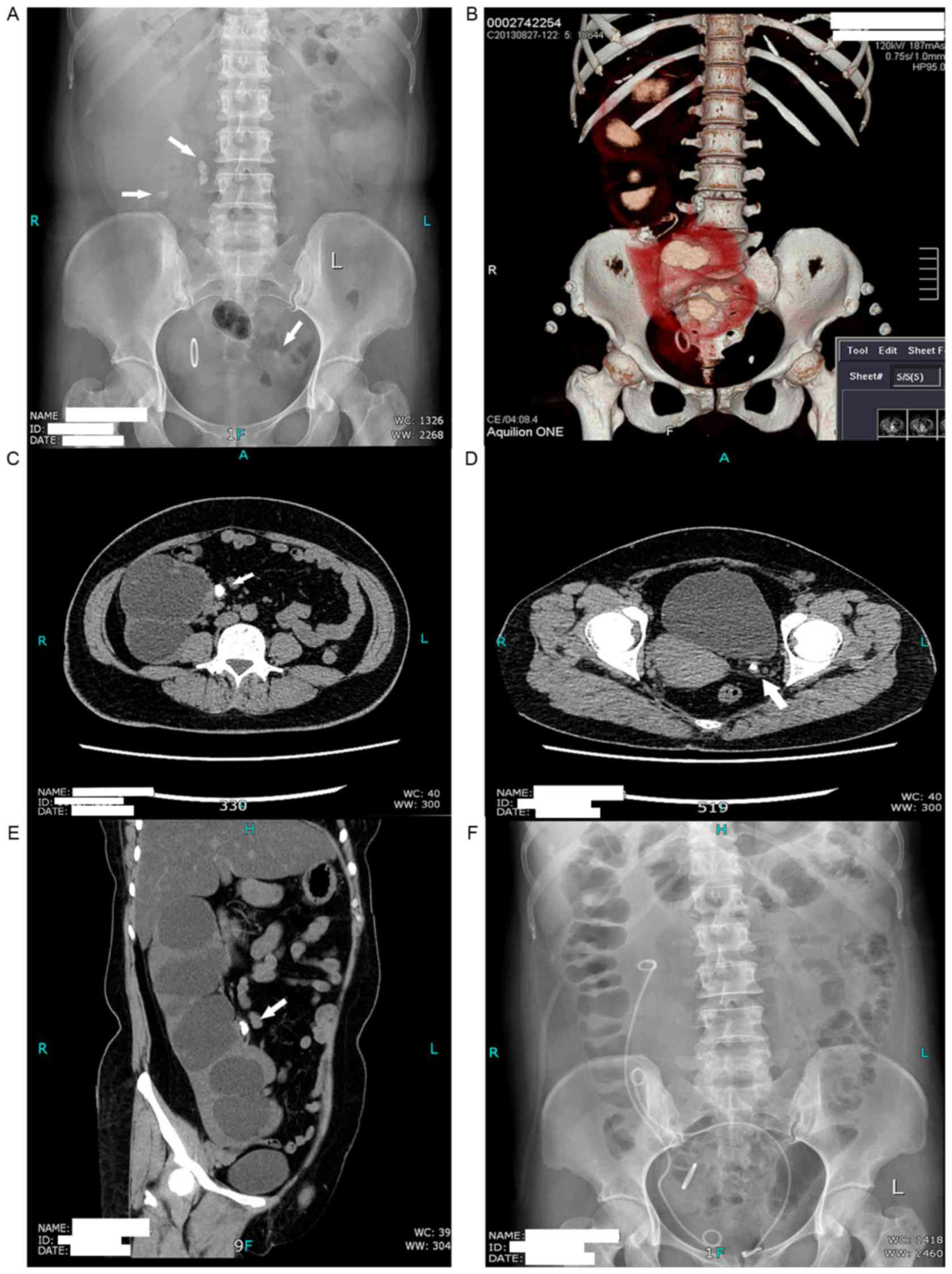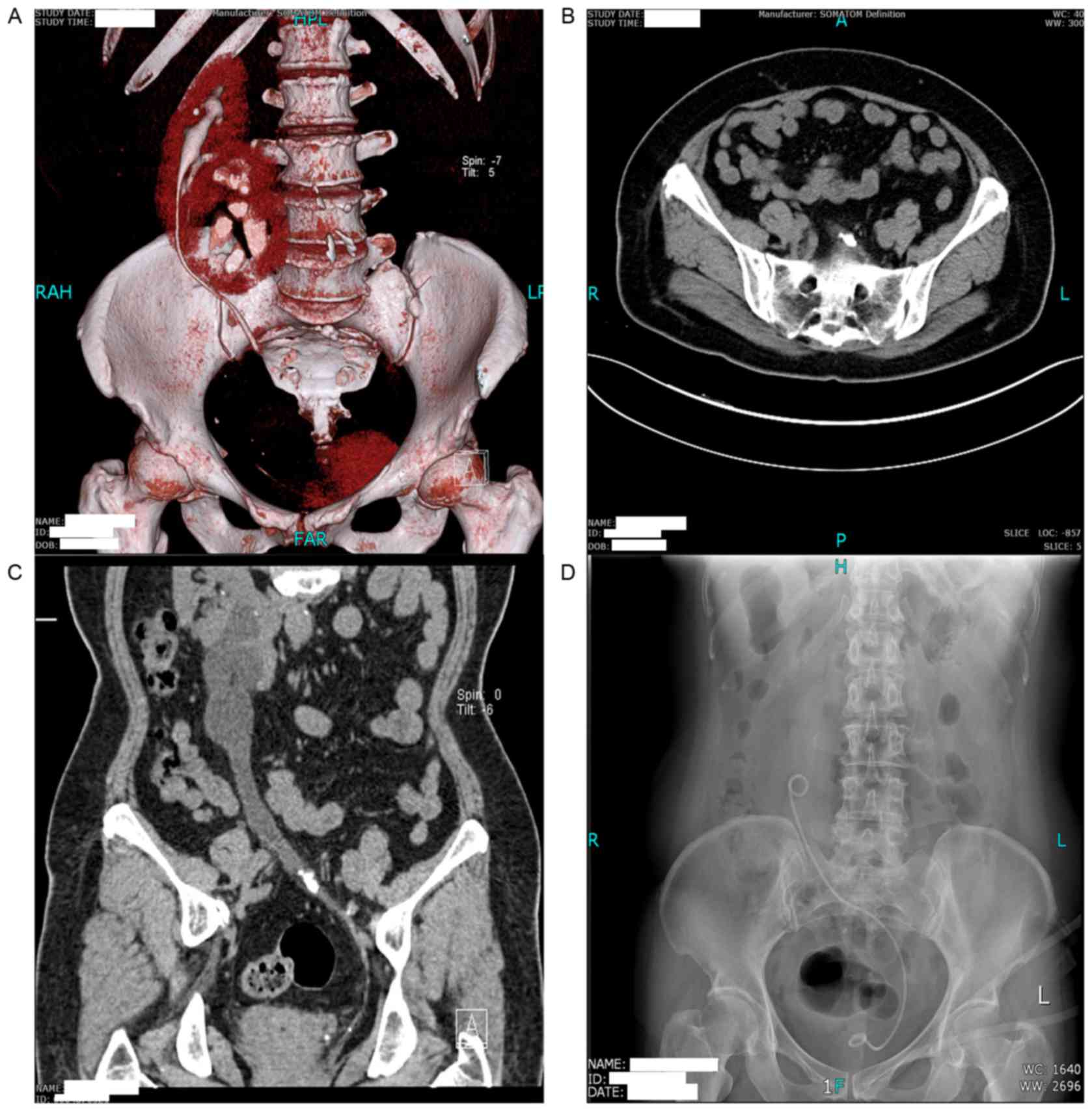|
1
|
Shapiro E, Bauer SB and Chow JS: Anomalies
of upper urinary tractWein AJ, Kavoussi LR, Novick AC, Partin AW
and Peters CA: Campbell Walsh Urology. 10th. Philadelphia: Elsevier
Saunders; pp. 3140–3145. 2012
|
|
2
|
Ajayi S, Mamven M, Tabari A, Ojji D and
Ibrahim A: Crossed fused renal ectopia presenting as recurrent
lower abdominal pain and urinary tract infection. Afr J Med Med
Sci. 42:193–196. 2013.PubMed/NCBI
|
|
3
|
Solanki S, Bhatnagar V, Gupta AK and Kumar
R: Crossed fused renal ectopia: Challenges in diagnosis and
management. J Indian Assoc Pediatr Surg. 18:7–10. 2013. View Article : Google Scholar : PubMed/NCBI
|
|
4
|
Gupta NP, Mishra S, Seth A and Anand A:
Percutaneous nephrolithotomy in abnormal kidneys: single-center
experience. Urology. 73:7107142009. View Article : Google Scholar
|
|
5
|
Larré S, Carpentier X, Sèbe P, Tassart M,
Cussenot O and Traxer O: A report of unusual crossed fused renal
ectopia and minimal invasive management of calculi. Surg Radiol
Anat. 29:393–395. 2007. View Article : Google Scholar : PubMed/NCBI
|
|
6
|
Kato M, Ioritani N, Aizawa M, Inaba Y,
Watanabe R and Orikasa S: Extracorporeal shock wave lithotripsy for
a ureteral stone in crossed fused renal ectopia. Int J Urol.
7:270–273. 2000. View Article : Google Scholar : PubMed/NCBI
|
|
7
|
Mishra S, Ganesamoni R, Ganpule AP, Sabnis
RB and Desai MR: Supine percutaneous nephrolithotomy for bilateral
complete staghorn calculi in an L-shaped cross-fused renal ectopic
anomaly. Urology. 81:e3–e4. 2013. View Article : Google Scholar : PubMed/NCBI
|
|
8
|
Maldonado-Alcaraz E, Martinez-Vargas JA,
Moreno-Palacios J, Serrano-Brambila EA and Velázquez-Quintero S:
Percutaneous nephrolithotomy in crossed fused renal ectopia:
Superior calyceal access under fluoroscopic control. Arch Esp Urol.
65:582–585. 2012.(In English, Spanish). PubMed/NCBI
|
|
9
|
Abdeldaeim HM, Hamdy SA and Mokhless IA:
Percutaneous nephrolithotomy for the management of stones in
anomalous kidneys in children. J Pediatr Urol. 7:239–243. 2011.
View Article : Google Scholar : PubMed/NCBI
|
|
10
|
Srivastava A, Gupta P, Chaturvedi S, Singh
P, Kapoor R, Dubey D and Kumar A: Percutaneous nephrolithotomy in
ectopically located kidneys and in patients with musculoskeletal
deformities. Urol Int. 85:37–41. 2010. View Article : Google Scholar : PubMed/NCBI
|
|
11
|
Ghosh BC, DeSantis M, Kleyner Y and Zak Y:
Crossed fused renal ectopia with calculi. J Am Coll Surg.
206:7532008. View Article : Google Scholar : PubMed/NCBI
|
|
12
|
Aminsharifi A, Niroomand R, Kroup M and
Hosseini MM: Laparoscopic nephrolithotomy in a patient with crossed
fused renal ectopia. Nat Rev Urol. 6:675–679. 2009. View Article : Google Scholar : PubMed/NCBI
|
|
13
|
Ugurlu IM, Akman T, Binbay M, Tekinarslan
E, Yazici ö, Akbulut MF, Özgör F and Müslümanoğlu AY: Outcomes of
retrograde flexible ureteroscopy and laser lithotripsy for stone
disease in patients with anomalous kidneys. Urolithiasis. 43:77–82.
2015. View Article : Google Scholar : PubMed/NCBI
|
|
14
|
Resorlu M, Kabar M, Resorlu B, Doluoglu
OG, Kilinc MF and Karakan T: Retrograde intrarenal surgery in
cross-fused ectopic kidney. Urology. 85:e5–e6. 2015. View Article : Google Scholar : PubMed/NCBI
|
|
15
|
Taslim BB, Abdulwasiu BA, Olusegun S,
Oluwatoyin AC and Omolara MM: Crossed renal ectopia coexisting with
nephrolithiasis in a young Nigerian man. Arab J Nephrol Transplant.
5:107–110. 2012.PubMed/NCBI
|
|
16
|
Yan Z, Xie G, Yuan H and Cheng Y: Modular
flexible ureteroscopy and holmium laser lithotripsy for the
treatment of renal and proximal ureteral calculi: A single-surgeon
experience of 382 cases. Exp Ther Med. 10:1467–1471. 2015.
View Article : Google Scholar : PubMed/NCBI
|
|
17
|
Nadu A, Schatloff O, Morag R, Ramon J and
Winkler H: Laparoscopic surgery for renal stones: Is it indicated
in the modern endourology era? Int Braz J Urol. 35:9–18. 2009.17–8.
View Article : Google Scholar : PubMed/NCBI
|
|
18
|
Rana AM and Bhojwani JP: Percutaneous
nephrolithotomy in renal anomalies of fusion, ectopia, rotation,
hypoplasia, and pelvicalyceal aberration: Uniformity in
heterogeneity. J Endourol. 23:609–614. 2009. View Article : Google Scholar : PubMed/NCBI
|
|
19
|
Bhojwani N, Hartman JB, Ahmed M, Morgan R
and Davidson JC: Management of ureteral obstruction in crossed
fused renal ectopia: A case report. Can Urol Assoc J. 8:E752–E744.
2014. View Article : Google Scholar : PubMed/NCBI
|
|
20
|
Amin MU, Khan S and Nafees M: Crossed
fused renal ectopia with staghorn calculus and gross
hydronephrosis. J Coll Physicians Surg Pak. 19:69–70.
2009.PubMed/NCBI
|
|
21
|
Singer A, Simmons MZ and Maldjian PD:
Spectrum of congenital renal anomalies presenting in adulthood.
Clin Imaging. 32:183–191. 2008. View Article : Google Scholar : PubMed/NCBI
|
|
22
|
Moosanejad N, Firouzian A, Hashemi SA,
Bahari M and Fazli M: Comparison of totally tubeless percutaneous
nephrolithotomy and standard percutaneous nephrolithotomy for
kidney stones: a randomized, clinical trial. Braz J Med Biol Res.
49:e48782016. View Article : Google Scholar : PubMed/NCBI
|
|
23
|
Blackburne AT, Rivera ME, Gettman MT,
Patterson DE and Krambeck AE: Endoscopic Management of Urolithiasis
in the Horseshoe Kidney. Urology. 90:45–49. 2016. View Article : Google Scholar : PubMed/NCBI
|
|
24
|
Aminsharifi A, Irani D, Masoumi M,
Goshtasbi B, Aminsharifi A and Mohamadian R: The management of
large staghorn renal stones by percutaneous versus laparoscopic
versus open nephrolithotomy: A comparative analysis of clinical
efficacy and functional outcome. Urolithiasis. 44:551–557. 2016.
View Article : Google Scholar : PubMed/NCBI
|
|
25
|
Elbir F, Başıbüyük İ, Topaktaş R, Kardaş
S, Tosun M, Tepeler A and Armağan A: Flexible ureterorenoscopy
results: Analysis of 279 cases. Turk J Urol. 41:113–118. 2015.
View Article : Google Scholar : PubMed/NCBI
|
|
26
|
Palmero JL, Durán-Rivera AJ, Miralles J,
Pastor JC and Benedicto A: Comparative study for the efficacy and
safety of percutaneous nefhrolithotomy (PCNL) and retrograde
intrarenal surgery (RIRS) for the treatment of 2–3,5 cm kidney
stones. Arch Esp Urol. 69:67–72. 2016.(In English, Spanish).
PubMed/NCBI
|
|
27
|
Gokce MI, Tokatli Z, Suer E, Hajiyev P,
Akinci A and Esen B: Comparison of shock wave lithotripsy (SWL) and
retrograde intrarenal surgery (RIRS) for treatment of stone disease
in horseshoe kidney patients. Int Braz J Urol. 42:96–100. 2016.
View Article : Google Scholar : PubMed/NCBI
|
















